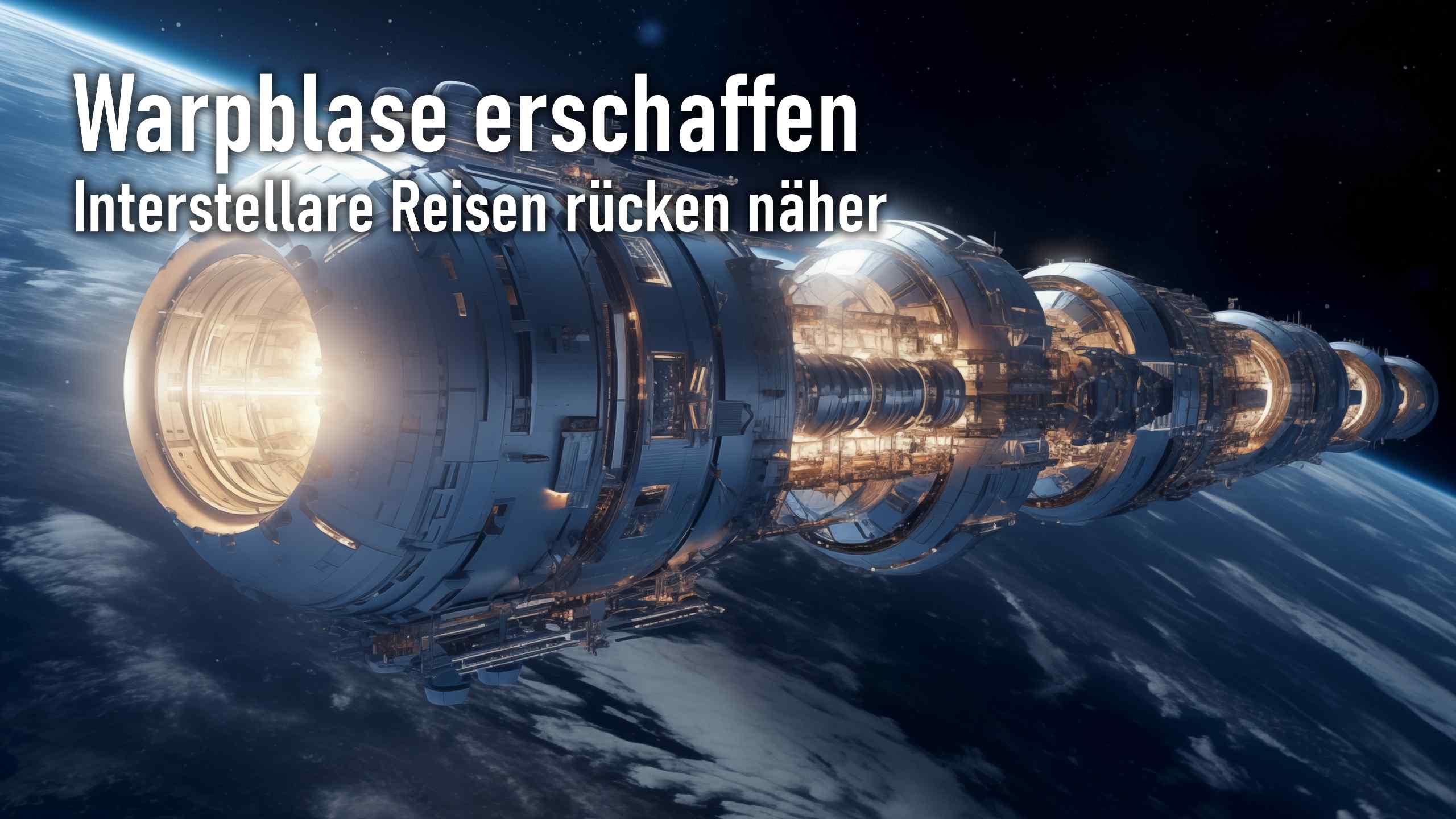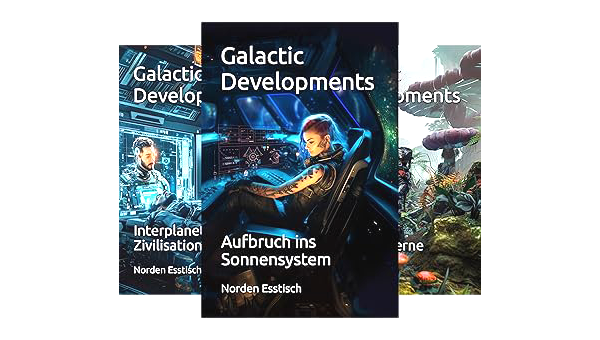
2247 Raumverschiebung durch Manipulation der Raumzeitmetrik

Eine Auswahl von Schlagzeilen zum größten Durchbruch des Jahrhunderts:
- "Quantensprung: Wissenschaftler falten den Raum" - Lagrange Times, allgemeiner Nachrichtenkanal.
- "Physiker erschaffen Warp-Blase" - Shackleton Metro, Newsfeed.
- "Mit der Raumzeitverschiebung kommt die Menschheit interstellaren Reisen näher" - Per Anhalter, Magazin für kommerzielle Raumfahrt.
- "Raumschiff Udyama wird Realität" - That's No Moon, SciFi-Magazin.
- "Raumzeitblase ebnet den Weg zu galaktischen Reisen" - Giga Xinxi, Buzz-Generator.
- "Revolution in der Physik: negative Masseteilchen verbiegen die Raumzeit" - The Bubble, KI-gesteuerter investigativer Journalismus, der riesige Datensätze analysiert, um Geschichten zu enthüllen.
- "Das Universum steht uns offen: Wissenschaftler verzerren Raum-Zeit in historischem Experiment" - Elektrische Schafe, unterbewusster Traumnachrichtenfeed und Bildungsprogramm.
- "Nobelpreis für Raumzeitblase" - RL-Reporter, ein Nachrichtendienst in VR-Welten, der über Ereignisse in der realen Welt berichtet (RL: reales Leben).
- "Science-Fiction wird Real: Echte Raumblase erschaffen" - AndClickTheBellIcon, Video-Nachrichtensprecher im Retro-Stil, ein sogenannter Tuber.
- "Erster kontrollierter Raumzeitsprung im Weltraumlabor" - Der Raum-Teleoperator, ein BotOps-Spezialmagazin der Hikikomori Virtual Nagaya Vereinigung.
- "Durchbruch in der Raumzeit-Manipulation - Überlichtschnelle Reisen bald Realität" - Benutzer "You talkin to me?" auf TauChan, einer Greynet-Newsgroup.
- "Quantenspiegel und negative Masse: Die Zukunft der Raumfahrt" - Gravity 4 ya all, populärwissenschaftlicher Unterkanal des Ingenieursverbands IEEE Gravity SIG.
- "Ein kleiner Sprung für eine Blase und ein großer Schritt für die Quantenphysik" - Alles-Q, Subgreen (Newsgroup) auf Greenit.
- "Raumzeitblasen steuern mit Quantenverschränkung" - TunnelDefect, Magazin für Quantencomputer-Bastler.
- "Warp-Antrieb in Sicht: Wissenschaftler machen riesige Fortschritte in der Kontrolle der Raumzeit" - Standard Disclaimer, ein Mega-Slinker.
Die Entwicklung von einer physikalischen Theorie zum Durchbruch des Jahrhunderts:
Mitte des 22. Jahrhunderts wird die Spin-Graphen-Quantenraumzeit, die SGQS-Theorie (SGQS = Spin Graph Quantum Spacetime) formuliert. SGQS löst die Unvereinbarkeit von Quantenmechanik und allgemeiner Relativitätstheorie. Die Theorie ebnet damit den Weg zur bedeutendsten wissenschaftlichen Errungenschaft des Jahrhunderts.
In den 70er Jahren des 22. Jahrhunderts werden dann Quantenspiegel entwickelt, die durch schwache Symmetriebrechung virtuelle Teilchenpaare trennen. Dabei entstehen kurzlebige Teilchen mit effektiv negativer Masse. Der Prozess erzeugt einen partiellen Ereignishorizont, der nur für bestimmte Teilchen gilt. Bisher waren virtuelle Teilchen mit negativer Masse eher eine theoretische Kuriosität. Jetzt können sie praktisch benutzt werden und die naheliegende Anwendung ist die Krümmung der Raumzeit auf sehr kleine Skalen.
In den folgenden Jahrzehnten gibt es weitere experimentelle Fortschritte: die Technologie der lokalisierten Higgs-Feldverschiebung (LHFS) stabilisiert die Teilchen mit negativer Masse über längere Zeiträume. Außerdem gelingt es mit Quantenverschränkung, einzelne Teilchen über ihren jeweiligen Ereignishorizont hinweg zu steuern.
Bei der Metric Field Research Facility (MFRF), einer Einrichtung für Experimente mit Raumzeitmetrik im weiten Erdorbit, laufen neue physikalische Theorien und aktuelle Technologien zusammen. Die Einrichtung ähnelt einem riesigen Teilchenbeschleuniger. Dort wird eine Maschine gebaut, die Raum in kleinen Bereichen krümmen kann. Tausende von Wissenschaftlern, Ingenieuren und Technikern arbeiten mit Teilchenbeschleunigern, Speicherringen und Fabriken für exotische Teilchen. Mehrere große Fusionsreaktoren versorgen die energieintensiven Anlagen über ein Energie-Hohlleiternetz.
Im Jahr 2247 gelingt am MFRF die erste kontrollierte Raumzeitverschiebung. Die Bewegung im Femtometermaßstab – das sind nur Bruchteile eines Atomkerns – ist eine praktische Anwendung der Theorie der Spin-Graphen-Quantenraumzeit. Das Experiment erzeugt eine Raumzeitblase und verschiebt sie relativ zum umgebenden Raum.
Der Nobelpreis geht in diesem Jahr an:
- dy leitendy Wissenschaftly des MFRF-Projekts,
- die theoretische Physikerin, die eine experimentell testbare Lösung der SGQS-Theorie gefunden hatte, und an
- den Manager eines Vorläuferexperiments, in dem viele für die erste Raumverschiebung verwendeten Technologien entwickelt wurden.
Für den Durchbruch des MFRF-Experiments mussten viele Probleme gelöst werden. Die Raumzeitblase ist zwar ein wissenschaftliches Wunder, aber anfangs ist sie instabil. Die Verschiebung der mikroskopischen Raumblase benötigt eine gigantische Energiemenge. Und sobald die Blase wieder freigegeben wird, kehrt der umschlossene Raum an seine ursprüngliche Position zurück. Dabei wird die in der gekrümmten Raumzeit gespeicherte Energie frei. Diese Instabilität führt zu mehreren großen Explosionen. Dem begegnet man durch den Bau von Einweg-Experimenten, eine langsame und teure Methode.
Im Jahr 2287 bringt die Anwendung der isochoren Skalierung von Grundarfjördur-Zilberstein eine weitere große Verbesserung. Mit Grundarfjördur-Zilberstein gelingt es, die Raumzeitverschiebung dauerhaft zu machen. Grundarfjördur und Zilberstein bekommen dafür einen weiteren Nobelpreis.
In einer parallelen Entwicklung kann das Volumen der gekrümmten Raumzeit deutlich reduziert werden, während gleichzeitig das eingeschlossene Volumen wesentlich vergrößert wird. Zum Beginn des 24. Jahrhunderts erreichen die künstlichen Raumblasen makroskopische, das heißt, mit bloßem Auge sichtbare Größenordnungen: von Nanometern zu einigen Metern innerhalb 40 Jahren.
Trotz dieser Fortschritte ist der Weg zur praktischen Anwendung noch weit. Die größte Herausforderung besteht darin, dass die Raumzeitblase von innen heraus erzeugt und gesteuert werden muss, damit sie als Antrieb für Raumschiffe dienen kann. Diese Weiterentwicklung braucht weitere sechs Jahrzehnte und insgesamt dauert es mehr als 100 Jahre, um aus dem Demonstrator der Raumverschiebung ein einfaches Antriebssystem zu machen.
Diese ersten reaktionslosen Antriebe nach dem Prinzip gekrümmter Raumzeit sind noch viel langsamer als die Lichtgeschwindigkeit. Es sind riesige energiehungrige und empfindliche Konstruktionen. Sie sind anfällig für Störungen durch die Gravitation naher bewegter Massen und ihren fraktal strukturierten Konverterflächen werden schon von den kleinsten Teilchen im Raum beschädigt: von Mikrometeoriten, aber auch von den Eisenkernen der kosmischen Strahlung. Die Wartung dieser Antriebe ist aufwändig und mit langen Ausfallzeiten verbunden.
Trotzdem ist der Erfolg von 2247, die erste künstliche Raumzeitverschiebung der Menschheit, ein wichtiger Durchbruch auf dem Weg zu unkonventionellen, reaktionslosen – und irgendwann auch überlichtschnellen – Raumschiffantrieben.
Im Laufe eines weiteren Jahrhunderts erreichen Raumkrümmer – scheinbare – Geschwindigkeiten im Prozentbereich der Lichtgeschwindigkeit. Gleichzeitig wächst ihre Zuverlässigkeit und die Kosten sinken. Und dann, mehr als 200 Jahre nach der ersten mikroskopisch kleinen Raumzeitverschiebung, gewinnt das erste von Menschen gebaute Raumschiff das Rennen gegen sein eigenes Licht.
Mehr Wissenschaft
2160 KI macht Physik
2208 Entdeckung des Octopus Sapiens
2247 Quantensprung
2248 Gemini-Katastrophe
2255 Isochore Skalierung
2305 Optimale Verhandlungsergebnisse
2349 Omikron-Ereignis
2397 Scharfes Auge
2410 Urknall-Theorie widerlegt
2458 Durchbruch
2501 Extraplanetare Forschung
2668 Ultrametalle
2746 Medizinischer Durchbruch
3042 Galaxien
3308 Supernova
3347 Betriebsstart von Argus
Neue Beiträge
2326 Kein interplanetarer Krieg
3050 Königliche Garde
3090 Solo Ehre
2234 Am Ende des Orbits
2248 Gemini-Katastrophe
2366 Orbitale Ökonomie
2222 Weltraumpiraten
2312 Kaio-Artefakt
3361 Erste Menschheit
2333 Metrische Impulsverstärkung
2337 Verschwörung im Orbit
2247 Quantensprung
2158 Space Patrol
2284 Trennung der Erde
2321 Isolation der Erde
2205 Unternehmensnationen
2192 Antiexpansionistischer Terror
2179 Private Asteroidenbasis
2231 Vereinte Planeten
2291 Verbotene Forschung
Die Besten
(20 von 75)
2197 Mond-Revolte
2205 Unternehmensnationen
2222 Weltraumpiraten
2234 Am Ende des Orbits
2291 Verbotene Forschung
2303 Raumhändler-Putsch
2326 Kein interplanetarer Krieg
2501 Extraplanetare Forschung
2532 Panik im Sonnensystem
2540 Mukhagni-Zwischenfall
2630 Verschwörung gegen die Menschheit
2725 Auch Maschinen haben ein Gewissen
2794 Prophet der galaktischen Händler
2841 Leuchtender Tempel
2844 Digitale Entdeckung
2949 Königin von Marduk
3010 Wiederbesiedlung Kisors
3090 Solo Ehre
3270 12.000 Jahre Geschichte
3353 Tor der Kontroverse
 2246
Infomorph-Enklave
2246
Infomorph-Enklave

 2248
Gemini-Katastrophe
2248
Gemini-Katastrophe